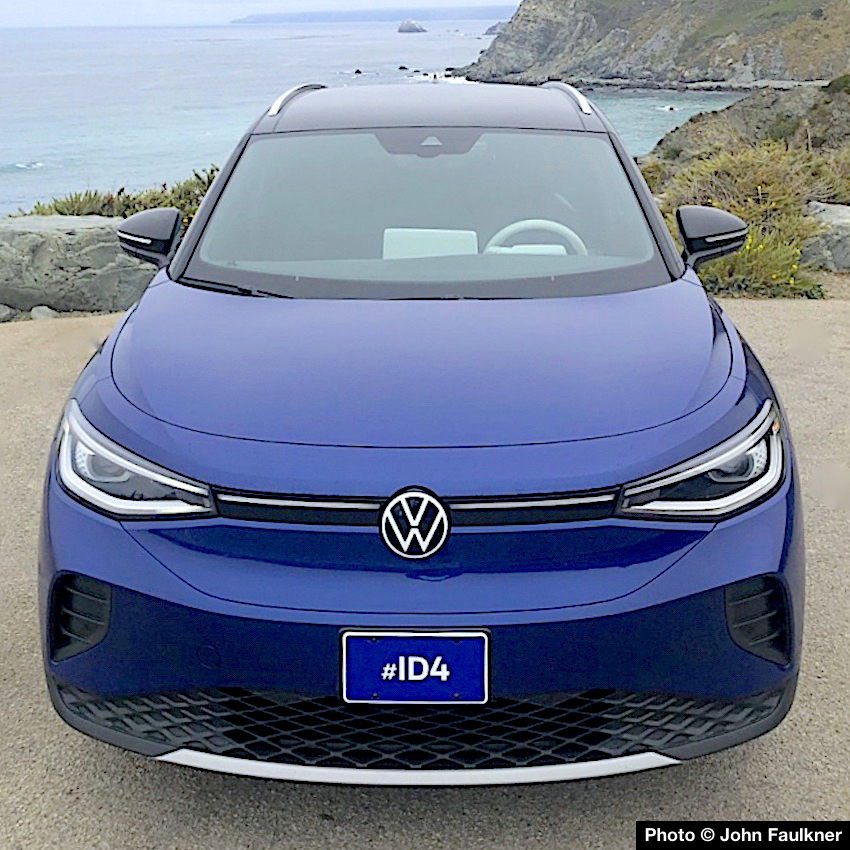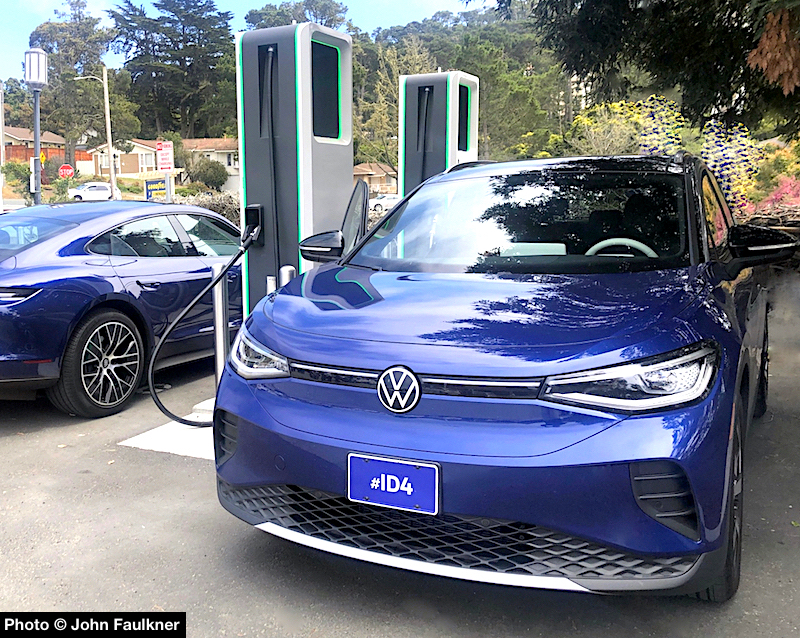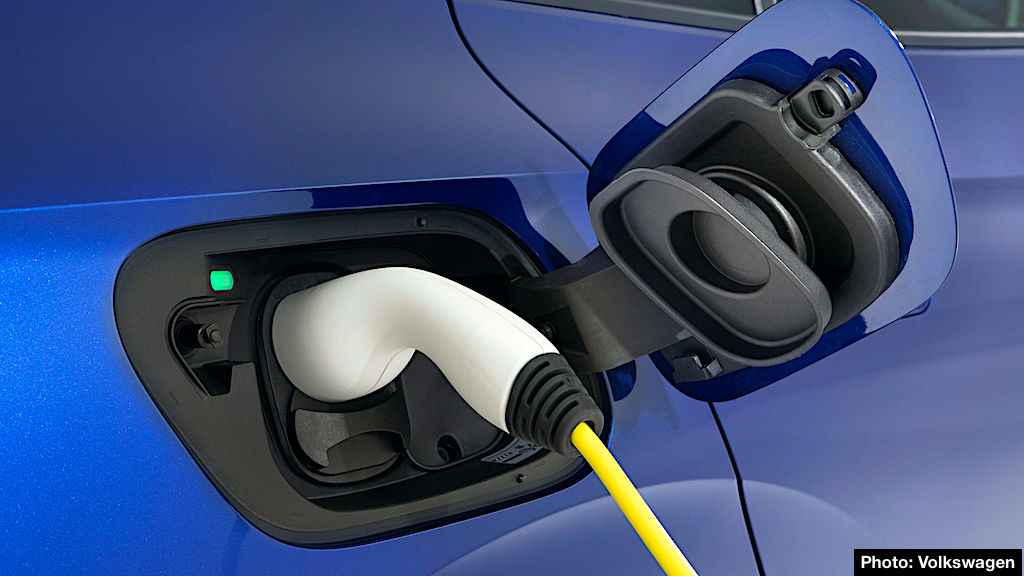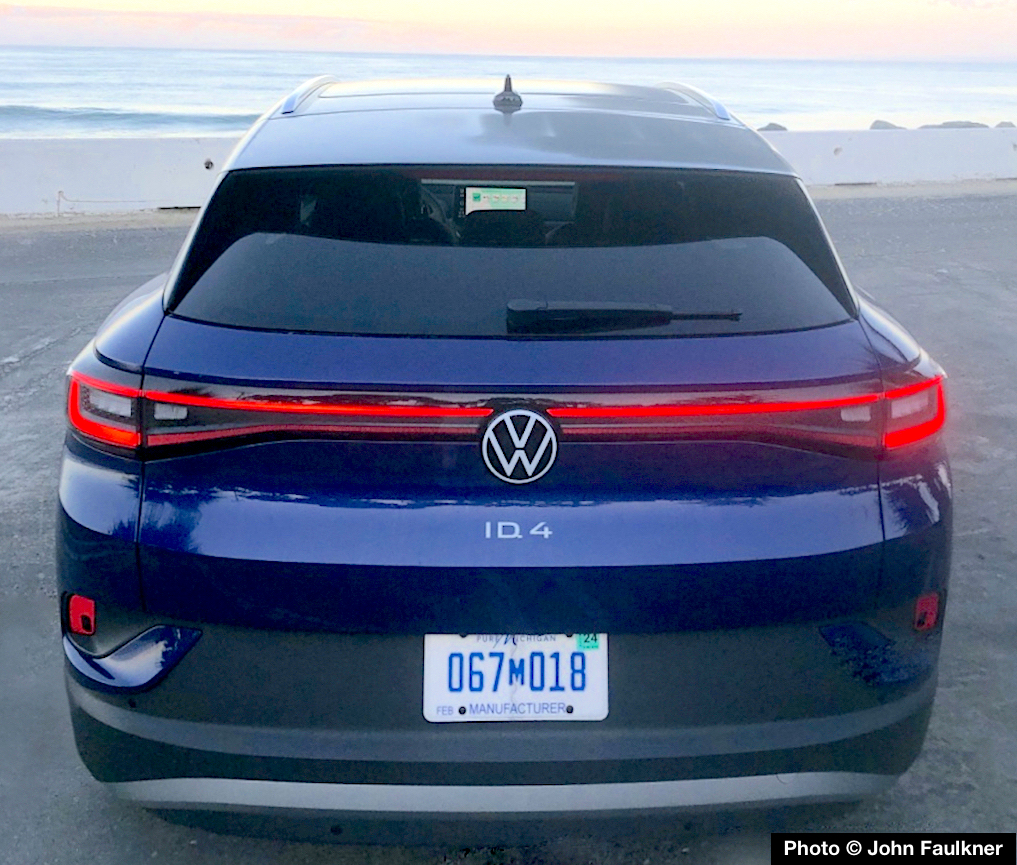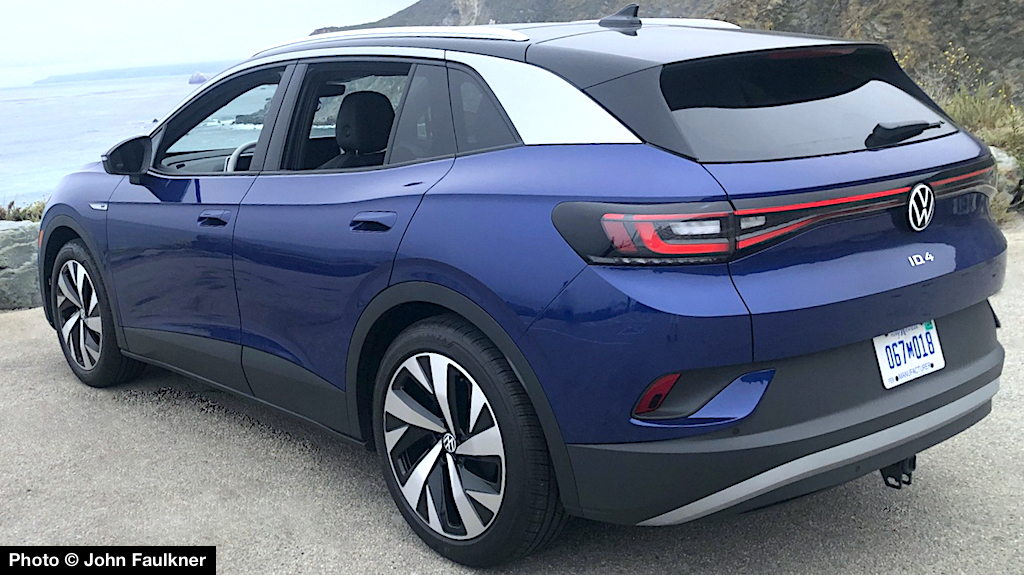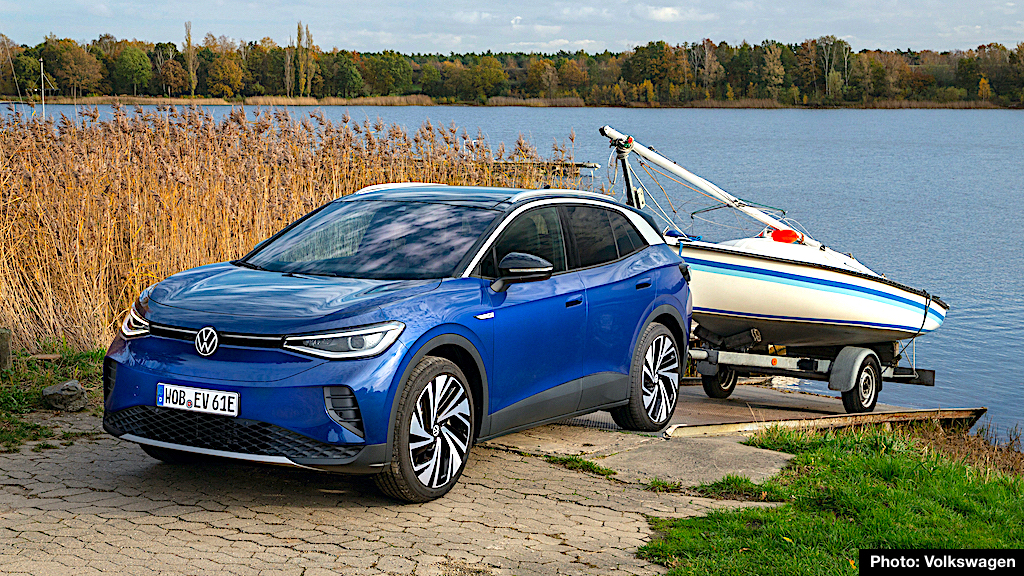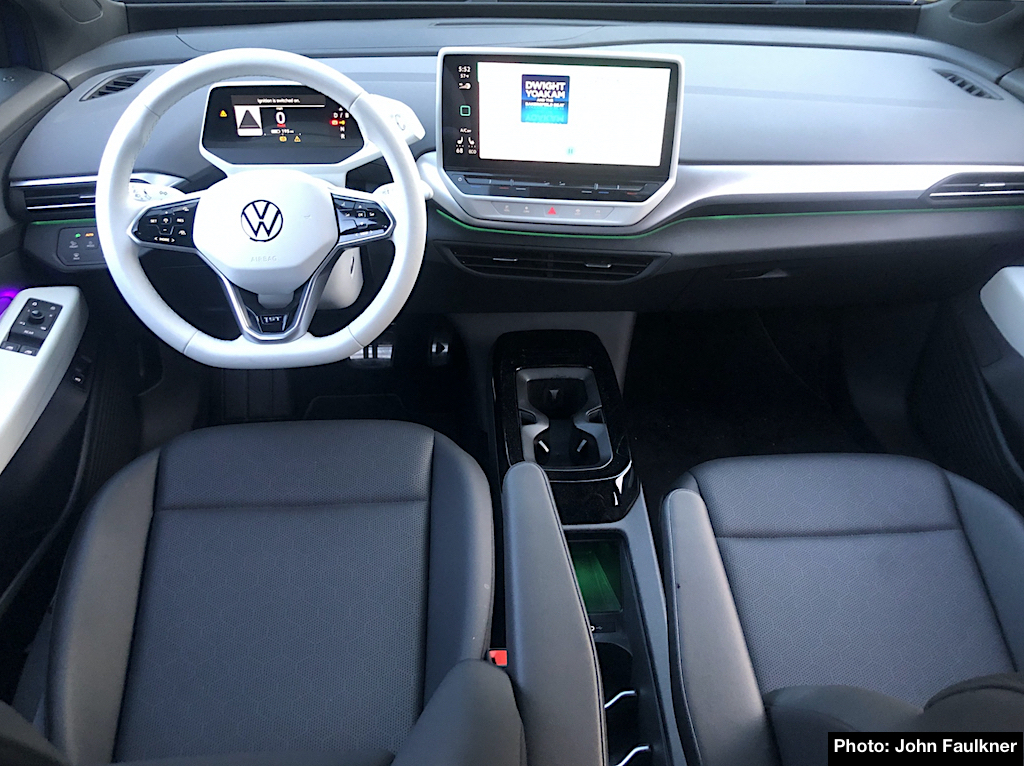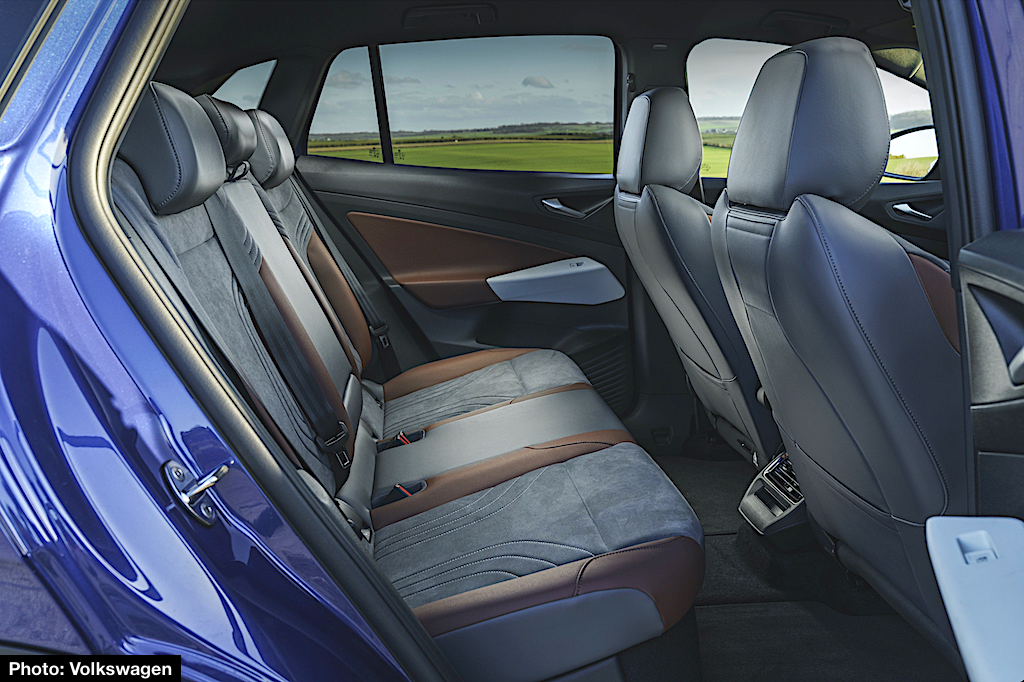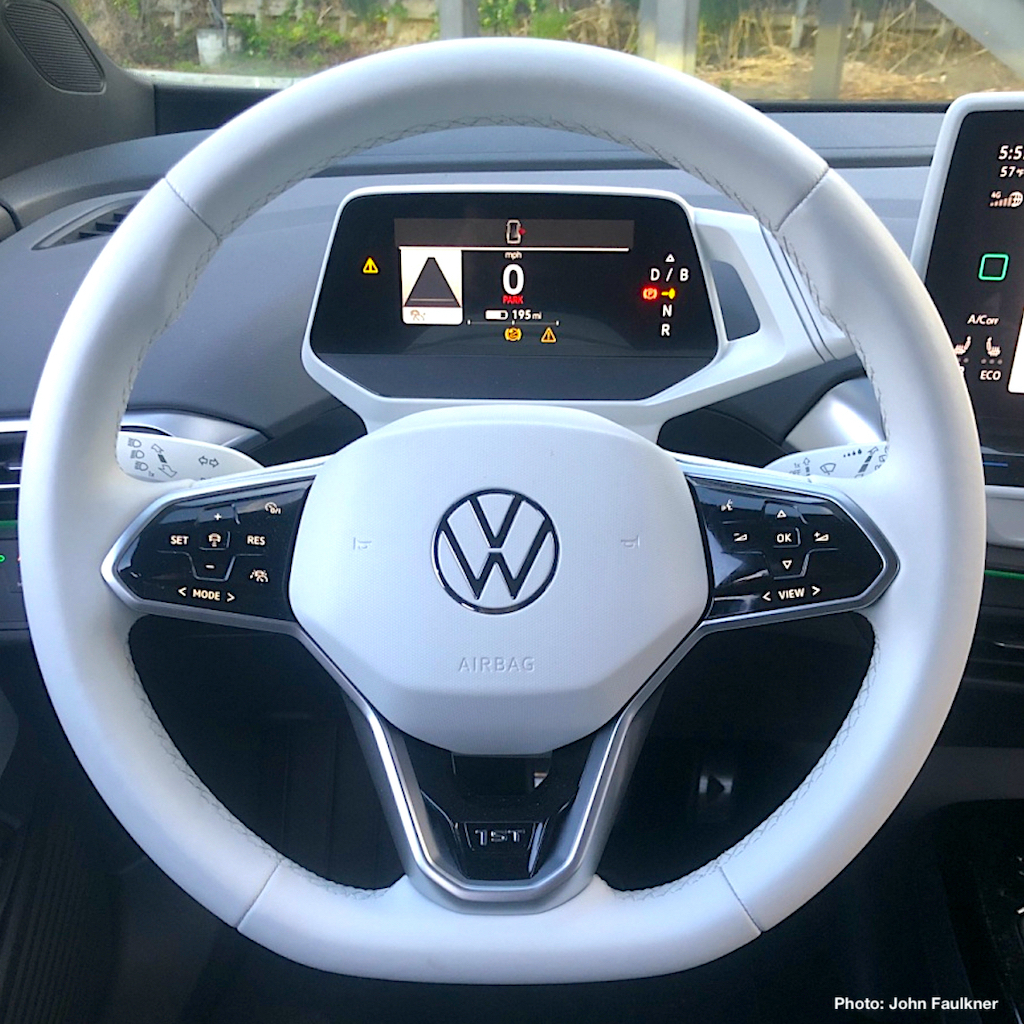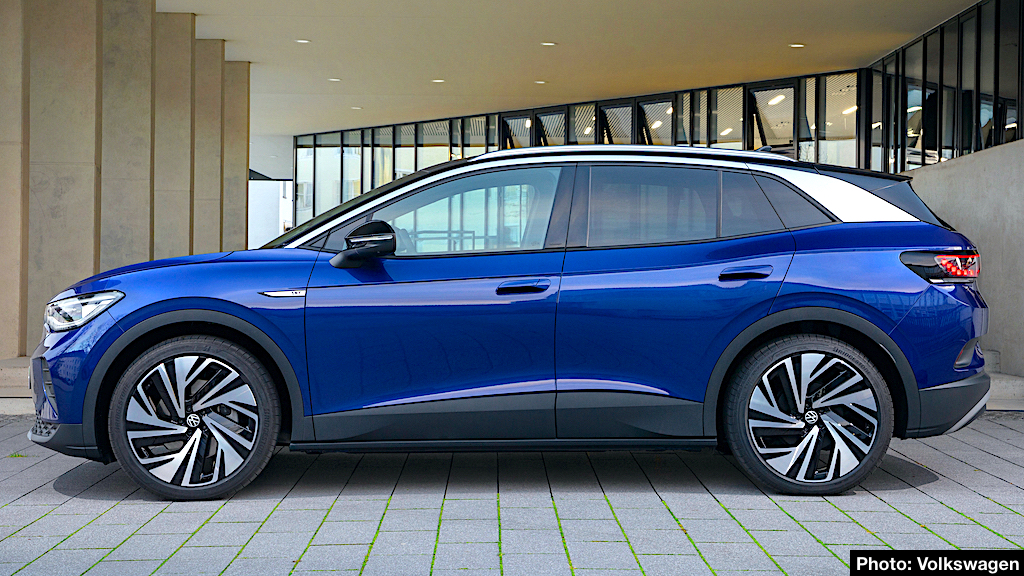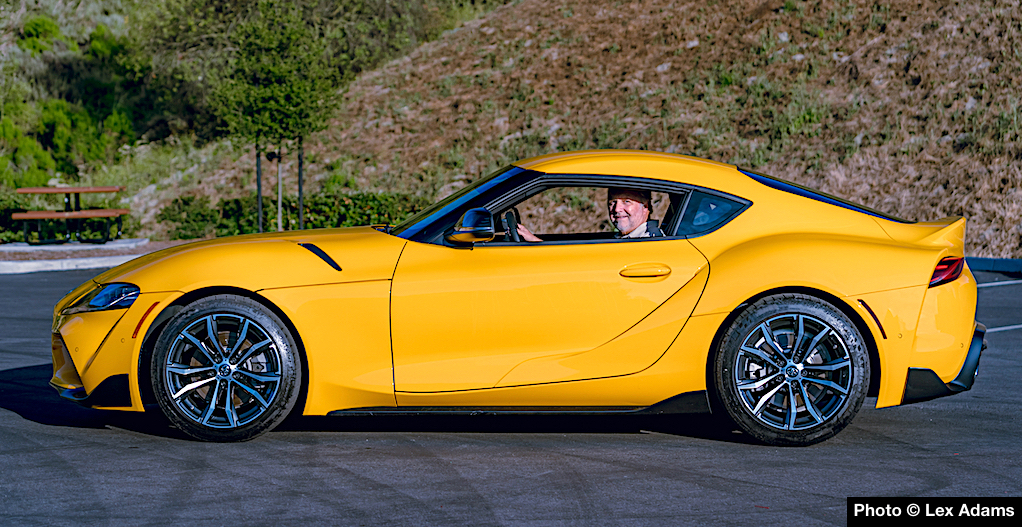By John Faulkner Clean Fleet Report
The all-new, electric 2021 Volkswagen ID.4, after a few years of teasing, is now at your local dealer. For Volkswagen fans the wait was worth it, especially those familiar with the excellent e-Golf, which was discontinued after 2019. Volkswagen is hoping the compact crossover ID.4 will change the way people look at electric cars. They want it to be seen as modern in its design and features, while offering electric efficiency with an estimated 250 miles of driving range.
It is generally accepted an electric car is ideal for an emissions-free daily commute or making local trips bopping around town. But what about venturing out further, on a trip that usually would be taken in a gasoline powered car? To see how this would work, Volkswagen agreed to let Clean Fleet Report take the ID.4 on a 985-mile California Cruising road trip. I found with proper route planning, and the fast charging capability of the ID.4, making a trip of this length is not only very doable, but an enjoyable experience. First a bit about the ID.4, and then about the road trip.
ID.4 Technology
The initial ID.4 models have rear-wheel drive; all-wheel drive comes in 2022. Its single motor produces 201 horsepower (hp) and 229 pound-feet (lb.-ft.) of torque, powered by a 77-kilowatt-hour (kWh) lithium-ion battery. The Environmental Protection Agency (EPA) rates the driving range at 250 miles, with an impressive 97 MPGe (miles per gallon equivalent), a measure of the powertrain’s efficiency. MPGe is a measurement of how far a car can travel, electrically, on the same amount of energy as is contained in 1 gallon of gasoline (or 33.7 kWh).
The battery is charged through a plug-in port offering three basic charging speeds. Using an onboard 11 kW charger, here’s the shake-out of the different levels of charging:
- 120V (typical household plug, Level 1) – Adds two-to-three miles of range per hour
- 240V (Level 2) – As little as 7.5 hours to full charge from fully depleted
- 480V DC Fast Charging – To 80 percent charge in 38 minutes or less (from five percent)
Additional charging comes from regenerative braking, which converts kinetic energy into electricity when braking or coasting. Driving around town, stuck in stop-and-go rush hour freeway traffic or coasting down hills will recharge the battery. The battery state-of-charge and mileage range are monitored in real-time by a dash gauge.
Charging
A major part of my California Cruising road trip was to exclusively use the Electrify America charging network, which was established by Volkswagen in 2016 as mitigation of the diesel emissions settlement with the US government.
With the ID.4 rated at a 250-mile driving range, recharging stops were planned to happen with 40-50-percent battery remaining. Below is how it went in the real world. Note: The ID.4 computer constantly measures and updates driving range based on your recent driving pattern. Therefore, some of the driving range numbers below (after a full charge) are due to the computer recognizing I was easy on the throttle.
Dana Point to Santa Clarita (120 miles)
- State Of Charge (SOC): 52% battery remaining
- 47 minutes on a 350 kilowatt (kW) charger for a 288-mile driving range estimate
Santa Clarita to Shell Beach (166 miles)
- SOC: 30% battery remaining
- 45 minutes on a 350 kW charger for a 258-mile driving range estimate
Shell Beach to Los Gatos (149 miles)
- SOC: 40% battery remaining
- 54 minutes on a 350 kW charger for a 255-mile driving range estimate
Los Gatos to Pleasant Hill (70 miles)
- SOC: 80% battery remaining
- 25 minutes on a 150 kW charger for a 247-mile driving range estimate
Pleasant Hill to Coalinga (189 miles)
- SOC: 23% battery remaining
- 40 minutes on a 150 kW charger for a 215-mile driving range estimate
Coalinga to Santa Clarita (170 miles)
- SOC: 40% battery remaining
- 60 minutes on a 50 kW charger for a 210-mile driving range estimate
Santa Clarita to Dana Point (120 miles)
- SOC: 52% battery remaining
- 47 minutes on a 150 kW charger for a 248-mile driving range estimate
Some Thoughts on Charging
The first thing to do with any charging company is to download its app, and follow the steps to register a credit card. In the case of Electrify America, you can also use its charge stations by simply swiping a credit card.
Charging with Electrify America is fairly straight-forward, but I did need to call its 24/7 customer help line one time. The representative was knowledgeable and patient as we went through my issues. I was not the only person needing assistance, as at two of our charging stops there were other drivers on the phone with Electrify America. With this said, the process was no more unique than charging with one of Electrify America’s competitors.
When you pull up to an Electrify America charging station, there may be three options to choose from: 50 kW, 150 kW or 350 kW. Your intuition is to wait for the 350 kW charger as it would seem to be the one delivering the fastest charge. That isn’t always necessary as it doesn’t quite work that way.
The 2021 Volkswagen ID.4 has a maximum acceptance rate or maximum power rating of 125 kW. This means it is not important to match the ID.4’s maximum acceptance rate with the charging station. So plugging into a 50 kW charger will only charge at 50 kW. But using either the 150 kW or 350 kW chargers will result in the ID.4 being charged at a rate up to the 125 kW maximum acceptance rate.
In the chart above for the Coalinga to Santa Clarita leg, I used a 50 kW Electrify America charger for an hour, resulting in 210 miles of driving range. Compare this to the other legs where I used either a 150 kW or 350 kW charger, which resulted in more miles in the same or less time.
When using a DC fast charging network such as Electrify America, the ID.4 will only charge the battery at the fastest speed up-to 80 percent. The charger then slows until the battery reaches 100 percent. Volkswagen, as well as other EV manufacturers, recommend charging to 80 percent to prevent overcharging and deteriorating the battery. This is why when looking at the technical specifications on an electric car, the charging is typically listed as “X minutes to 80%.”
For all new ID.4 owners, Volkswagen is covering the electric charging cost for the first three years. This program is only on the Electrify America charging network, which is what we used exclusively on our 985-mile California Cruising road trip.
The most common charging options are Level 2 (AC 240V) and Level 3 (DC fast charging), but there is one more: Level 1. The ID.4 can be charged with a common, 120V household plug for topping-off a faster charge, or if it is the only charging option available. You can expect two-to-three miles of range per hour with the Level 1 charger, so a completely drained battery in the ID.4 could take up-to three days to produce 250 miles. Over the years I have used this method over night for 10 to 12 hours, which delivers enough charge to get to a faster charging station.
The Driving Experience
Powered by a single electric motor driving the rear wheels, the 201 hp and 229 lb.-ft. of torque are plenty to move the ID.4’s 4,465 pounds. While not as fast as some EVs that never stop crowing about their 0-to-60 times, the ID.4 delivers strong, even acceleration with that torque available at any time and any speed. Our 0-60 time was right around 7.3 seconds, which is plenty fast to zip around in traffic when necessary.
The ID.4 shines on the open road. On our 985-mile California Cruising road trip we spent the majority of our time in the 55-65 mph range. Open road cruising can be an issue with an electric car, as non-stop driving typically isn’t regenerating any electricity back into the battery to augment driving range. Any concern was wiped away once we saw how efficiently the ID.4 was using the battery charge, consistently delivering 3.0 to 3.3 driving miles per kWh, which is very good.
Locating the batteries under the seats made for a sure-footed driving experience, with excellent road feel coming from the electric power steering that thankfully was not programmed to take away the fun of driving. Body roll was only felt when pushed above recommended corner speed limits. As noted, highway cruising was solid and confident.
The ID.4 comes with 235/50 Bridgestone Alenza all-season tires mounted on 20-inch aluminum alloy wheels. A 20-inch tire can sometimes make for a rough ride, but not on the ID.4, as they were matched perfectly for ride comfort, quietness and cornering grip. The balance was very neutral, making for a pleasant ride quality. The turning radius was impressive, making for easy U-turns in your neighborhood. Overall, the ID.4 is easy-to-drive, but should not be considered a sports crossover.
The ID.4 has two drive modes of D and B – D for Drive and B for Brake, which doesn’t apply the brakes, but does increase the regeneration. There are no steering wheel-mounted paddles to modulate and increase the regeneration, so the ID.4 cannot be driven in one-pedal mode.
One-pedal is where an electric vehicle can be slowed and even brought to a complete stop without using the brake pedal. Electric vehicles that have one-pedal capability typically add more energy to the battery and help with driver fatigue.
The more the ID.4 can be slowed with regenerative braking, the better. Using the electric motor to slow the car, and not the brakes, reduces brake system wear. When it does come to using the brakes, the ID.4 has standard ABS (Anti-lock Braking System), and power-assisted front vented and rear solid discs. Handling and driving confidence was also aided by the standard electronic stability control, electronic brake-pressure distribution and brake assist.
Classic German Design
If you are a fan of classic German design, the all-new 2021 ID.4 will not disappoint. The front end leads off with a distinctive illuminated light bar, which runs horizontally through the VW badge, connecting the sleek LED projector headlights located on the outer fender edges. The faux grille making-up the lower fascia has a diamond pattern that Volkswagen says helps with aerodynamics. The ID.4 has a short hood compared to its Lighting things up competitors, resulting in no front trunk (frunk). This goes against the current design trend on electric cars, but made sense when Volkswagen explains the reasons.
The smooth sides, with flush door handles, have a crisp character line that extends to the hands-free power liftgate. The unadorned hood leads to a raked windshield, which is part of the greenhouse that appears to be rear-leaning. The gently sloping roof has a shark fin antenna and roof rails, ending with an integrated spoiler. The rear of the ID.4 may be the most interesting angle as the C-shaped LED taillights, connected by a slim LED light strip, give off a great look at night. The ID.4 design has a drag coefficient of 0.28, which produces minimal wind noise when at freeway speeds.
The ID.4 comes with a trailer hitch for towing up-to 2,200 pounds. This could handle a small trailer, but expect your electric range to be cut dramatically.
Looking Forward Interior
The interior of the ID.4 is airy, modern, futuristic and could even be considered sparse (though not Tesla Model Y sparse). Large windows and the panoramic glass roof make for a bright cabin, which really popped against the white steering wheel and armrests. The seats on our ID.4 1st Edition were covered in black V-Tex, a synthetic leather with the look of leather, but more durable and at less cost. The heated front seats were 12-way power adjustable, including lumbar, and even had massage, a feature rarely found on a vehicle at this price.
The front seats were supportive and had plenty of rear travel for the tallest drivers. The center console can be reconfigured for cups or other items, but the hidden storage space is small. The center armrests fold up and down, but are narrow and don’t offer the same support as a larger, padded center console. The power sunshade for the glass roof was crucial to not bake, and the 30-color adjustable ambient interior lighting was soothing. Make sure to check-out the geometric shape of the puddle lights coming off the outside mirrors.
The rear seat, with a fold-down center armrest, sits a bit higher than the front seats, offering rear passengers a good view out the windshield. The leg and headroom are ample, accommodating two adults easily, three for shorter trips, and access through the wide rear doors. Lift-over in the rear was easy.
The rear seat splits 60/40, folds flat, and has a ski pass-through. With the rear seats up there is 30.3 cubic feet of cargo capacity, which expands to 64.2 cubic feet with the rear seat folded flat. For additional storage space, the rear floor in the cargo area can be dropped, and below it is a well for storing, among other things, the charging cord.
The sleek dash is devoid of buttons and knobs, meaning a combination of voice commands, touches and swipes are used to interact with the systems, features and functions. Some controls can be found on the heated, leather-wrapped steering wheel. The gear selector is on the upper right of the adjustable steering column, with forward, neutral and rear gears chosen by rotating a rocker switch. It was easy to use, and its location opens up space on the center console.
An interesting feature of the ID.4 is, you do not need to actually start the motor, with the key inside the cabin. Once sitting in the driver’s seat, just press the brake pedal and rotate the gear selector, and off you go. This works when leaving also, just exit the ID.4 and it turns off. However, the car can also be started and stopped by pushing the chrome button on the steering column.
There are only two switches to operate the four windows, which at first seemed odd, but then made sense. There is a capacitive touchpoint that illuminates “Rear”, which is what will be selected to operate the rear windows. Touch it again, and it defaults to the front windows. The dual-zone automatic climate control is operated by slide touch points, or by selecting the Climate icon on the touch screen and going through the settings.
German interiors are known for clean fit and finishes; the ID.4’s had a good mix of soft and hard plastics. The driver-centric design has a 5.3-inch information screen that is not attached to the dash, and appears to float as it sits on the steering column. It is positioned well visually and is a clever design, but it lacks some of the driver-useful information that is almost universally found on other electric vehicles.
What is found on the screen is a small battery icon showing driving range, a digital speedometer, gear choices and an overly large space showing lane positioning and icons for any driver assistance features that are turned on. On all other cars, the driver can toggle through several pages, showing a wide range of helpful information. Having recently reviewed the all-new 2022 Volkswagen Taos compact crossover, we found a very comprehensive driver information screen, which means Volkswagen has the ability to add additional content to the ID.4.
Taking center stage on the dash of our ID.4 1st edition was the Discover Pro Max 12.0-inch color touchscreen that handles navigation, the rear view camera, and the seven-speaker sound system. The FM/HD radio, with SiriusXM® (90-day subscription) had four USB-C ports. There is Bluetooth for telephone, radio control and streaming music.
Standard on all ID.4 trim levels is Volkswagen’s Car-Net® connected car technology that provides a seamless Wi-Fi link between the car and an iPhone, Android smartphone or computer.
Some Things Are Curious
To this point the ID.4 has performed great, has proved itself to be a good value that should be considered when shopping for an EV. With that said, there is some curious technology that, at least for me, did not enhance the driving experience. None of these are deal breakers to ownership, but are noted because each are found on the 2021 Volkswagen crossovers such as the Atlas, Tiguan and Taos, meaning they could also be on the ID.4.
There are four Universal Serial Bus-C (USB) ports, two each front and rear. If you are not familiar with the USB-C, the plug end is smaller than the ubiquitous USB-A. The USB-C is slowly being introduced by mobile phones from Apple and Android, but by far the most common USB is the A size. Not having any USB-A ports on our California Cruising road trip meant my wife was unable, for a week, to charge her iPhone, as we did not have an adapter and her phone could not use the wireless charge pad. So when purchasing the ID.4, make sure to invest in a USB-A to C adapter.
The sound system was great, but the user interface was fussy, confusing and didn’t always work as designed. I noted earlier the sleek dash is devoid of buttons and knobs, meaning a combination of voice commands, touches and swipes are used to interact with the systems, features and functions. Not having knobs and switches for the radio and climate controls meant operating the radio required repeatedly touching the screen or waving your hand before the screen, in what Volkswagen calls “gesture control.”
This feature needs more work as it was quirky, slow to react or didn’t react at all. I drove my poor wife crazy trying to get the radio to perform a desired task; she sternly asked me to stop doing it! There are other traits with the radio that have a learning curve that in time can be overcome, but one that for me at least was a head scratcher: no AM band. Maybe it is generational thing, but what benefit is Volkswagen providing by not offering the AM band?
Voice commands were mostly accurate, but there were a few phone calls that didn’t go through, so they had to be dialed directly.
The front passenger sun visor doesn’t extend. Big deal and not even worth mentioning? It is when you realize Volkswagen probably has an extending sun visor in their parts bin and easily could have put it on the ID.4.
Safety
All 2021 Volkswagen ID.4s come with IQ.Drive, which includes advanced driver assistance systems (ADAS) such as forward collision warning and autonomous emergency braking with front pedestrian detection, active side assist blind spot monitor, rear traffic alert, lane assist, adaptive cruise control w/Stop & Go, Travel Assist and Emergency Assist.
With the Intelligent Crash Response System, in the case of an accident, the brakes are automatically applied by the automatic post-collision braking system so the car does not continue moving, resulting in a secondary accident. It also turns off the fuel pump, unlocks the doors, and switches on the hazard lights. This technology shows its value so an incapacitated driver is not injured further by their car striking another object.
Additional safety systems include a tire pressure monitoring system, automatic high-beam control, rear parking distance control sensors with park assist, power folding and heated outside mirrors and rain-sensing windshield wipers with heated washer nozzles.
Pricing
There are two 2021 ID.4 models, with these prices including the $1,195 destination fee, but no optional equipment. The ID.4 qualifies for federal and state credits, and in some states is eligible for a HOV sticker.
- Pro $41,190
- Pro S $45,690
Note: There’s a third model, the 1st Edition, priced at $45,190, but it’s sold out and no longer available at dealers. An all-wheel drive model is due to arrive later this year with an approximate $2,500 price premium compared to the current models.
Observations: 2021 Volkswagen ID.4
The first electric vehicle I reviewed for Clean Fleet Report was the 2013 Nissan Leaf. Wow, this technology has come a long way in less than a decade!
The all-new 2021 Volkswagen ID.4 is a comfortable and well-designed compact crossover. With tight handling and a smooth, quiet ride, the spirited all-electric driving experience lives-up to Volkswagen’s German heritage. The four-door ID.4 is solidly built, is efficient and can charge at a quick pace. The technology on-board needs to have some bugs worked out, but confidence is high they will be.
The ID.4 is the first American arrival of a series of all-electric cars and crossovers coming under the ID sub-brand, including the very cool ID.4 GTX high-performance model. Until then, the ID.4 is practical, priced right, and with the 250-mile driving range, will become the most popular and used vehicle in your household. Simply put, it is a very good family crossover.
About the Author
John Faulkner is Road Test Editor at Clean Fleet Report. He has more than 30 years of experience branding, launching and marketing automobiles. He is a journalist member of the Motor Press Guild.
ID.4 press fleet vehicle provided by Volkswagen America, Inc. Prices and vehicle information applies to U.S. market models, not including taxes, title, license, etc. All product information, including prices, features, and specifications, is subject to change without notice.
Photos (as noted) © 2021 John Faulkner and © 2020 Lex Adams. Additional photos courtesy of Volkswagen
Story © 2021 Clean Fleet Report – This review is reposted with permission on CarNichiWa.com
